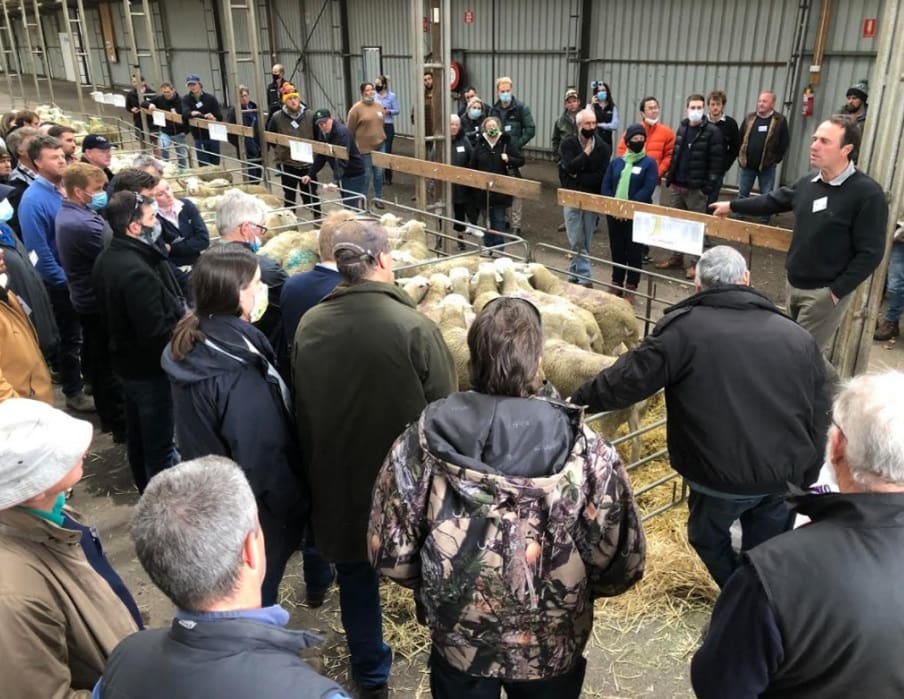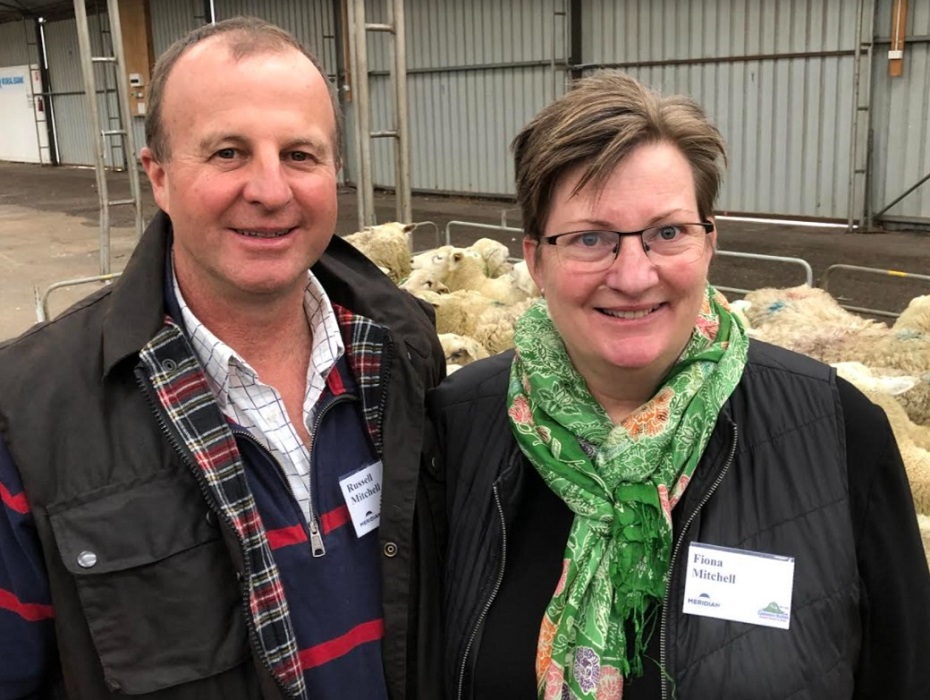
Composite and Nudie sheep breeder John Keiller, right, discusses his sheep at Hamilton.
IF Merino wool prices doubled Glenthompson sheep producers Russell and Fiona Mitchell would not turn back from their flock’s progression away from Merinos, to composites and now to Nudie shedding sheep.
The sheep farming journey of Mr Mitchell and his wife Fiona from fine wool production to prime lambs from maternal composite ewes and Nudies was the focus of a Meridian Agriculture workshop at the Hamilton Showgrounds yesterday.
The event, ‘Becoming a Nudie – The pros and cons of switching to shedding sheep’ attracted about 200 people, many of whom were composite ewe flock owners dissatisfied with current crossbred wool returns.
Mr Mitchell opened his presentation with the claim that despite being a Nudie farmer, he and his wife “don’t walk around without our gear on,” despite the wishes of their neighbour Jim.
The wool classer has been a shearing contractor running teams across Australia and an early PPP program and Lifetime Wool/Ewe adopter. He said he and his wife had “given wool everything we had,” but lost their love for wool and faith in the production and profitability of wool.
“We gave it everything we had, but we weren’t getting the rewards that we expected.”

Composite and Nudie sheep producers Russell and Fiona Mitchell.
He was introduced to composites and Nudies after a visit to John and Brigita Keiller’s composite and Nudie seedstock operation at Cashmore, with the Glenthompson BestWool BestLamb Group about 14 years ago. In his comparison of his Merino and maternal composite flock over a five year period, Mr Mitchell said he had an expectation of 60kgs of wool/hectare (about 125 bales from 1000 acres) and selling 2.8 units of meat/ha in wethers and culls.
“The composites were (producing) about 40kg of wool per hectare and 8.2 units of meat per hectare.”
He said the composites returned $350/hectare annually more than the Merinos over a five-year period, or about $140,000 per 1000 acres each year.
“So it was just really a no-brainer and as Rob Herrmann said before, you’ve got to enjoy what you do and we weren’t enjoying Merinos anymore.
“So we went with our head and not our heart and we got out of wool,” he said.
“We had the data and we had our own experience so that’s what we did.
“Around that time we thought, well, in our wool enterprise, if the meat side of it is supporting the wool side, why do we have wool in our meat enterprise, which is our composite production – so why don’t we give the Nudies a run, so we did?”
Grading up from a maternal composite flock
Mr Mitchell said they selected bare-bellied, short-woolled and open-faced composite ewes to join to Nudie rams. The first drop of Nudie cross lambs were kept separate because of the medullated fibre issue and have been crossed back to Nudie rams for the past five years. Composite ewes were retained in the Nudie ewe flock for about three years to maintain the influence of their composite genes, he said.
Mr Mitchell said the Nudies had to fit in with the farm’s normal plan; lambing in July and weaning in late September. Lambs are drafted three ways at weaning to start selling off pasture after the Melbourne Cup weekend, finishing in the first week of December off grass, with no lot-feeding, hay or summer crops. Based on weighing at weaning at about 13 weeks, Mr Mitchell said their composite lambs grow at about 360gms/day and the Nudies at about 330gms/day from birth. Last year’s lambs averaged 22.6kgs when sold, with the Nudies about 1.8kgs lighter than the composites, grossing about $14/head less. There would be a few more Nudies in the last truckload to go, he said.
“You would expect that because genetically they are not as strong, but they still fit in with our cycle so we are really happy with that.
“If the Nudies were a lot less productive and we had issues and we never felt we hand anything to lose we would have sold them and moved on,” he said.
“But we have faith in John (Keiller) and his direction and genetics and we think that they are only going to improve as the composites do at this stage.”
Mr Mitchell said the retained Nudie ewe lambs, more or less, reach the same weight and size of their full composite counterparts.
Mr Mitchell said the lambs are sold over the hook and there hasn’t been any price penalty for the Nudie lamb skins at this stage.
“They don’t tend to lose their wool at a younger age.”
Mr Mitchell said for the first few years the Nudie lambs were shorn, but by 2019 some didn’t need shearing, but these were shorn at 18 months of age.
“Some of the F3s (lambs) were getting quite bare so they didn’t need shearing.
“We shore everything in 2019 at the start of January and we never touched them again till January this year – we didn’t crutch them.
“So basically for two years we just had the normal animal husbandry and some of them had a bit of length in them.”
The 1.5-5 year-old Nudie cross ewes were drafted for cover and length, and 25pc did not need shearing, 25pc had a little saddle that he shore himself, and the rest were shorn by shearers.
“If we had enough of them I would have got 200 for the day.”
The wool tested at 29 micron and was sold for 182c/kg.
Biodegradable wool drops in the paddock
Mr Mitchell said not having to shear the Nudies is “such a bonus” and he is envisaging that most of his lamb drop this year won’t ever have to come into the shearing shed.
“Generally, we are at a point now where I’m estimating that at least half our flock will never come into the shed – our rams have never been in the shed.”
The Nudie flock is kept separate from the composites, although the joining and marking operations match.
He said wool dropped in the paddock or yards seems to disappear.
“The wool in the paddock is biodegradable … my mother-in-law has a worm farm and she puts woollen jumpers in there and the worms completely eat all that up and if it was acrylic or cotton they don’t do that.
“So that’s going on, on our farm, with that little bit of wool.
“As it goes on, there will be less wool and I imagine, at some point, there will be no wool, no shearing.”
Finding shearers has been an issue
Mr Mitchell said finding shearers had been an issue for him since 1988, when he was running a team near Hay in New South Wales. The wool price went from 600c/kg to 870c/kg, within a week we found it really hard to find shearers and shedhands, he said.
“It’s never really recovered from that.
“I think that’s one of the things that drove us to the Nudies, because the wool in composites is not a big profit driver.”
He said the Mitchell operation this year will sell 10 units of meat per hectare – ewe lambs, sale wethers and empty/aged ewes – and would produce about 35kg of wool per hectare.
“So let’s say 35kgs at 125-130c/kg that’s say $50.
“If we are selling 10 ewes/hectare that last year averaged $170, there’s $1700/hectare,” he said.
“So if wool doubled overnight, so we go from $50 to $100, it’s still not a major profit driver.”
He said with Merino wool production at 60kg/ha at a price of 1000c/kg for 19 micron or $600/ha and selling 2.8 units/ha, or about $430/ha, this would generate about $1430/ha “if we were still doing it,” he said.
“So if the Merino wool (prices) doubled today it would still only be coming up to parity with our composite structure, so I’m happy to be out of the industry and happy to be in the composite prime lamb industry.
“And I do think the future for that is perhaps with a shedding variety,” he said.
“I just don’t see the value with wool and it’s a hassle to get.”
Mr Russell said there wasn’t much difference in the lambing percentage between the composites and the Nudies.
“This year we had a conception rate of 162pc of single and twins … and our Nudies were exactly the same.
“The main difference is the early (lamb) growth rates.”
Mr Mitchell said in time they would develop the Nudies to “fill the back block”, leading to a 1/3 Nudie-2/3 composite flock.
He not seen the Nudie sheep challenged by extreme weather events and most paddocks have shelter. Mr Mitchell said he was not committed to joining ewe lambs, but Nudie ewe lambs had no problem getting to 40kg-plus, although only the better lambs were selected for Spring joining, with smaller lambs run on for another year.

Congratulations. What an eye opener. Many talk about sheep numbers going up again — I don’t believe they will — but with these sheep they may. Not that it will help the wool industry. Manufacturers have always found ways to push down the price of wool.